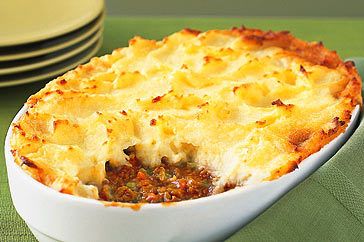
Gastronomic perfection
One of the things I miss the most about living outside England is shepherd’s pie. Americans just don’t get it.
First problem, encountered even in supposedly English pubs here in New York City, is that it’s usually made with beef. As I indignantly told a Liverpudlian waitress at the West Village establishment Fiddlesticks, this is straight mis-marketing. The dish’s name is clear: Shepherd’s Pie. That means it originated in sheep, which are tended by shepherds. Cows and shepherds don’t hang out. That’s why it’s not called ‘Cowboy Pie’, guys. There’s a name for the dish made from ground beef and mashed potato: cottage pie. Which is as different from Shepherd’s Pie as a hamburger is from a lamb chop.
Even when lamb is used in Shepherd’s Pie, American lamb is just not the same as agnus Britannicus. Not having been born in Wales or Montana -- both places where men are men and sheep are afraid -- I’m not an expert in lamb-rearing, slaughter, and preparation. So I don’t exactly know why the taste is different on each side of the Pond. But I have noted that American lamb lacks the rich range of tastes of British lamb. My mother once told me it’s because Americans don’t hang the lamb as long as the British, so the taste, presumably derived from the British process of putrefaction, is far more insipid.
The blandness might also be due to the horrific cocktail of hormones and chemicals that American farmers give to their livestock, as was revealed in the horror documentary, Food Inc.
Or it might stem from the different methods of preparation. Americans tend to use ground lamb rather than diced lamb shoulder chops. They rarely add that key tablespoon of Worcestershire sauce added to the mince. Sometimes they skimp on the sautéed carrots or the goblet of medium bodied red wine. Or they neglect to add both unsalted butter and an egg yolk to the mashed potatoes. The extra layer of onions between the meat and potato layers, put on after the onions in the mince have disappeared, is usually missing.
Then there’s the mashed-potato-versus-meat balance, that combination of protein and carbohydrate that ticks all the nutritional boxes. In America, the proportions always seem off. There’s either too much potato – which makes the whole experience vapid and unfulfilling -- or too much meat – rendering it stodgy and monotonous.
As for the creamed potato crust, the American version is consistently heartbreaking. It’s a flat grey wasteland. The correct, English way to do it, of course, is to sculpt a textured landscape of creamed potatoes, with peaks up to an inch high, and forked lines suggesting supernatural crop circles. Once it’s browned under the grill, a golden crunchy playground emerges, a metaphysical vista of gustatory anticipation.
Many of us English understand this fetish. As Rolling Stone Keith Richards wrote in his autobiography, Life: “It’s now famous, my rule on the road. Nobody touches the shepherd’s pie until I’ve been in there. Don’t bust my crust, baby. It’s written in the contract.”
This legendary connoisseur of the good life is deadly serious. The Stones’ publicist, Tony King, describes a terrible incident before a concert in Toronto, when some of the security staff had tucked into a shepherd’s pie left in the green room.
“Keith arrived and realized someone had broken the crust ahead of him. He demanded to know the names of all the people who had eaten the shepherd’s pie… I denied all knowledge, even though I’d had a piece. Keith said, “I’m not going on stage until another one is produced.” So they had to send out for another shepherd’s pie to be cooked and delivered. I had to say to Mick [Jagger], “Your show is running late because Keith doesn’t want to go on stage until he gets a shepherd’s pie. “Mick said, “You can’t be serious.” And I said, “I think I can on this occasion.” There was this scene in the backstage area, where on the walkie-talkies somebody actually said, “The shepherd’s pie is in the building!” And it got carried through the lounge and dropped into Keith’s dressing room, with some HP sauce, naturally. And he just stuck a knife in it and didn’t bother eating any of it and went on stage. Just wanted to cut the crust.”
Shepherd’s Pie is as English as Our Keef. It originated amongst sheep-farmers in northern Britain, probably in the seventeenth century, although the first time the name appears is in 1885, according to Wiltshire-born cookery writer Jane Grigson. It was usually eaten on Mondays, using the remains of the Sunday roast, a tradition that continues today.
The Irish have claimed, with little authority, that they invented it. Writer/actor Denis Leary claims that the Irish version first appeared in 1475, and was made with stout and sheep testicles. This is about as credible an assertion as it is that Jesus was born in Ireland. Potatoes didn’t even leave America for the British Isles until the mid-16th century, at the earliest.
The French have also tried to take the credit, with their plagiaristic, arriviste dish “hachis parmentier”, named after Antoine-Augustin Parmentier, an 18th century French pharmacist who promoted the potato as an edible crop. But the hachis parmentier came later to the table than English Shepherd’s Pie and almost always contains dead cow, not lamb.
The greatest desecration is found in Quebec, where they call it “Chinese pâté” (“pâté chinois”). To suggest this sacred dish has anything Chinese about it is preposterous. Potatoes rarely appear in Chinese cooking. I’ll concede that the Chinese may be our future Masters of the Universe, but I will never, ever renounce a steadfast claim on the glorious English heritage of Shepherd’s Pie.
